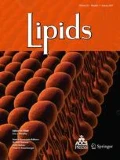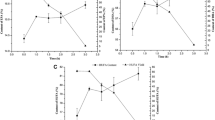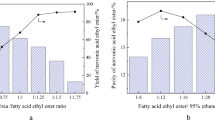Abstract
The aims of this study were to obtain concentrated pinolenic acid (5,9,12–18∶3) from dietary Korean pine (Pinus koraiensis) nut oil by urea complexation and to investigate its cholesteroi-lowering effect on the LDL-receptor activity of human hepatoma HepG2 cells. Pine nut oil was hydrolyzed to provide a low-pinolenic acid-containing FA extract (LPAFAE), followed by crystallization with different ratios of urea in ethanol (EtOH) or methanol (MeOH) as a solvent to produce a high-pinolenic acid-containing FA extract (HPAFAE). The profiles of HPAFAE obtained by urea complexation showed different FA compositions compared with LPAFAE. The long-chain saturated FA palmitic acid (16∶0) and stearic acid (18∶0) were decreased with urea/FA ratios (UFR) of 1∶1 (UFR1), 2∶1 (UFR2), and 3∶1 (UFR3). Linoleic acid (9,12–18∶2) was increased 1.3 times with UFR2 in EtOH, and linolenic acid (9,12,15–18∶3) was increased 1.5 times with UFR3 in MeOH after crystallization. The crystallization with UFR3 in EtOH provided the highest concentration of pinolenic acid, which was elevated by 3.2-fold from 14.1 to 45.1%, whereas that of linoleic acid (9,12–18∶2) was not changed, and that of oleic acid (9–18∶1) was decreased 7.2-fold. Treatment of HepG2 cells with HPAFE resulted in significantly higher internalization of 3,3′-dioctadecylindocarbocyanine-LDL (47.0±0.15) as compared with treatment with LPAFAE (25.6±0.36) (P<0.05). Thus, we demonstrate a method for the concentration of pinolenic acid and suggest that this concentrate may have LDL-lowering properties by enhancing hepatic LDL uptake.
Similar content being viewed by others
Abbreviations
- DiI:
-
3,3′-dioctadecylindocarbocyanine
- DiI-LDL:
-
DiI-labeled LDL
- HPAFAE:
-
high-pinolenic acid-containing FA extract
- LPAFAE:
-
low-pinolenic acid-containing FA
- MEM:
-
minimum essential medium
- UFR:
-
urea/FA ratio
- UPIFA:
-
unsaturated polymethylene-interrupted FA
References
Hollingsworth, P. (1997) Mainstreaming Healthy Foods, Food Technol. 51, 55–58.
Bloch, A., and Thomson, C.A. (1995) Position of the American Dietetic Association: Phytochemicals and Functional Foods, J. Am. Diet. Assoc. 95, 493–496.
Hardy, G. (2000) Nutraceuticals and Functional Foods: Introduction and Meaning, Nutrition 16, 688–689.
Lichtenstein, A.H. (1996) Dietary Fatty Acids and Lipoprotein Metabolism, Curr. Opin. Lipidol. 7, 155–161.
Phillipson, B.E., Rothrock, D.W., Connor, W.E., Harris, W.S., and Illingworth, D.R. (1985) Reduction of Plasma Lipids, Lipoproteins, and Apoproteins by Dietary Fish Oils in Patients with Hypertriglyceridemia, N. Engl. J. Med. 312, 1210–1216.
Imbs, A.B., Nevshupova, N.V., and Pham, L.Q. (1998) Triacylglycerol Composition of Pinus koraiensis Seed Oil, J. Am. Oil Chem. Soc. 75, 865–870.
Robert, L.W., Eric, D., and Jean-Charles, M. (1997) Positional Distribution of Δ5 Olefinic Acids in Triacylglycerols from Conifer Seed Oils: General and Specific Enrichment in the sn-3 Position, J. Am. Oil Chem. Soc. 74, 515–523.
Asset, G., Staels, B., Wolff, R.L., Bauge, E., Madj, Z., Fruchart, J.C., and Dallongeville, J. (1999) Effects of Pinus pinaster and Pinus koraiensis Seed Oil Supplementation on Lipoprotein Metabolism in the Rat, Lipids 34, 39–44.
Sugano, M., Ikeda, I., Wakamatsu, K., and Oka, T. (1994) Influence of Korean Pine (Pinus koraiensis)-Seed Oil Containing cis-5, cis-9,cis-12-Octadecatrienoic Acid on Polyunsaturated Fatty Acid Metabolism, Eicosanoid Production and Blood Pressure of Rats, Br. J. Nutr. 72, 775–783.
Kurushima, H., Hayashi, K., Toyota, Y., Kambe, M., and Kajiyama, G. (1995) Comparison of Hypocholesterolemic Effects Induced by Dietary Linoleic Acid and Oleic Acid in Hamsters, Atherosclerosis 114, 213–221.
Ibrahim, J.B., and McNamara, D.J. (1988) Cholesterol Homeostasis in Guinea Pigs Fed Saturated and Polyunsaturated Fat Diets, Biochim. Biophys. Acta 963, 109–118.
Gomes, T., and Caponio, F. (1997) Evaluation of the State of Oxidation of Crude Olive-Pomace Oils. Influence of Olive-Pomace Drying and Oil Extraction with Solvent, J. Agric. Food Chem. 45, 1381–1384.
Ko, S.N., Kim, H., Lee, K.T., Ha, T.Y., Chung, S.H., Lee, S.M., and Kim, I.H. (2003) Optimization of Enzymatic Synthesis of Structured Lipid with Perilla Oil and Medium Chain Fatty Acid, Food Sci. Biotechnol. 12, 253–256.
Graham, J.M., Higgins, J.A., Gillott, T., Taylor, T., Wilkinson, J., Ford, T., and Billington D. (1996) A Novel Method for the Rapid Separation of Plasma Lipoproteins Using Self-Generating Gradients of Iodixanol, Atherosclerosis 124, 125–135.
Stephan, Z.F., and Yurachek, E.C. (1993) Rapid Fluorometric Assay of LDL Receptor Activity by DiI-Labeled LDL, J. Lipid Res. 34, 325–330.
Lowry, O.H., Rosebrough, N.J., Farr, A.L., and Randall, R.J. (1951) Protein Measurement with Folin Phenol Reagent, J. Biol. Chem. 193, 265–275.
Cho, B.H., Dokko, R.C., and Chung, B.H. (2002) Oleic, Linoleic and Linolenic Acids Enhance Receptor-Mediated Uptake of Low Density Lipoproteins in Hep-G2 Cells, J. Nutr. Biochem. 13, 330–336.
Hayes, D.G., Bengtsson, Y.C., Van Alstine, J.M., and Setterwall, F. (1998) Urea Complexation for the Rapid, Ecologically Responsible Fraction of Fatty Acids from Seed Oil, J. Am. Oil Chem. Soc. 75, 1403–1409.
Grompone, M.A. (1992) Enrichment of Omega-3 PUFAs from Fur Seal Oil, Fat Sci. Technol. 94, 388–394.
Author information
Authors and Affiliations
Corresponding author
About this article
Cite this article
Lee, JW., Lee, KW., Lee, SW. et al. Selective increase in pinolenic acid (all-cis-5,9,12–18∶3) in Korean pine nut oil by crystallization and its effect on LDL-receptor activity. Lipids 39, 383–387 (2004). https://doi.org/10.1007/s11745-004-1242-2
Received:
Accepted:
Issue Date:
DOI: https://doi.org/10.1007/s11745-004-1242-2




